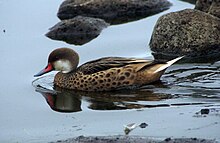白脸针尾鸭
白脸针尾鸭(学名:Anas bahamensis)又名巴哈马针尾鸭,是一种钻水鸭,最早由瑞典生物学家卡尔·林奈于1758年在其著作《自然系统第十版》中描述发表[2]。
| 白脸针尾鸭 | |
|---|---|

| |
| 分布于加拉巴哥群岛的白脸针尾鸭亚种A. b. galapagensis | |
| 科学分类 | |
| 界: | 动物界 Animalia |
| 门: | 脊索动物门 Chordata |
| 纲: | 鸟纲 Aves |
| 目: | 雁形目 Anseriformes |
| 科: | 鸭科 Anatidae |
| 属: | 鸭属 Anas |
| 种: | 白脸针尾鸭 A. bahamensis
|
| 二名法 | |
| Anas bahamensis | |
| 亚种 | |
|
3种,详见内文 | |

| |
外形
编辑白脸针尾鸭体长为38-51公分,身体与头顶为棕色,与脸部与喉部的白色呈鲜明对比是其特征。喙的基部是红色,其他部分则为灰色。雌雄鸭外表差异不大。因其特征明显,不易与其分布范围内的其他种鸭混淆[3]。
分类
编辑- A. b. bahamensis(Linnaeus, 1758)[4]:指名亚种,分布于加勒比海岛屿和南美洲北部与巴西东北部的海岸[3],也作为迷鸟出现在美国佛罗里达州南岸[5]。
- A. b. rubirostris(Vieillot, 1816)[4]:体型最大的亚种,分布于南美洲,也作为迷鸟出现在福克兰群岛[1]。可能有部分迁徙行为,在阿根廷等地产卵,并于较北处过冬。
- A. b. galapagensis(Ridgway, 1890)[4]:体型最小的亚种,头顶棕色与脸部的白色区域间没有明显分界[5]。分布于加拉巴哥群岛。
白脸针尾鸭一般被认为与赤嘴鸭关系密切,有人将两者从鸭属中另独立成一属Poecilonetta[3]。2009年一项分子系统发生学研究以粒线体DNA序列分析鸭科各物种的亲缘关系,发现在鸭属中,白脸针尾鸭是尖尾鸭、赤嘴鸭与黄嘴针尾鸭的姊妹群[6]。
生态
编辑白脸针尾鸭分布于加勒比海岛屿、加拉巴哥群岛与南美洲[7],通常栖息于咸淡水湖(盐度介于海水与淡水间的水域)、河口湿地与红树林沼泽中,在近水草丛中筑巢[7]。全年均可繁殖,一年可产5至12颗蛋,小鸭孵出所需天数尚未确定,但被认为与尖尾鸭相似,为22至24天。孵化后45至60天小鸭长出飞羽。只有雌鸭参与孵蛋与照护幼鸭的工作[5]。白脸针尾鸭的天敌甚多,除了被人类猎捕外,老鼠、狗、笑鸥、黄顶夜鹭与蓝色陆地蟹都会攻击其巢穴,其幼鸭甚至有被美洲牛蛙捕食的纪录[5]。
饲养
编辑白脸针尾鸭受养鸟人士欢迎,是一种常被饲养的水鸟。有些被饲养的个体逃脱后已在欧洲形成半野生的族群。养鸟界已培育出一种称为巴哈马银针尾鸭(Silver Bahama pintail)的白化变种[4]。
参考资料
编辑- ^ 1.0 1.1 Anas bahamensis. The IUCN Red List of Threatened Species 2012. [2013-11-26].
- ^ (拉丁文) Linnaeus, C. Systema naturae per regna tria naturae, secundum classes, ordines, genera, species, cum characteribus, differentiis, synonymis, locis. Tomus I. Editio decima, reformata. Holmiae. (Laurentii Salvii). 1758: 124.
A. grisea, rostro plumbeo: macula laterali fulva, macula alarum viridi luteaque.
- ^ 3.0 3.1 3.2 3.3 Carboneras, C and Kirwan, GM. White-cheeked Pintail (Anas bahamensis). Handbook of the Birds of the World Alive.
- ^ 4.0 4.1 4.2 4.3 Cowell, Dan. Bahama Pintail / White-cheeked Pintail. Harteman Wildfowl. Jan Harteman. [2012-04-29]. (原始内容存档于2011-02-21).
- ^ 5.0 5.1 5.2 5.3 Anas bahamensis white-cheeked pintail. Animal Diversity Web. 密西根大学动物学博物馆. [2018-07-24]. (原始内容存档于2018-07-25).
- ^ Gonzalez, J.; Düttmann, H.; Wink, M. Phylogenetic relationships based on two mitochondrial genes and hybridization patterns in Anatidae. Journal of Zoology. 2009, 279: 310–318. doi:10.1111/j.1469-7998.2009.00622.x.
- ^ 7.0 7.1 Madge, Steve; Burn, Hilary. Wildfowl: An Identification Guide to the Ducks, Geese and Swans of the World (Helm Identification Guides). Christopher Helm. 1988: 224–225. ISBN 0-7470-2201-1.
